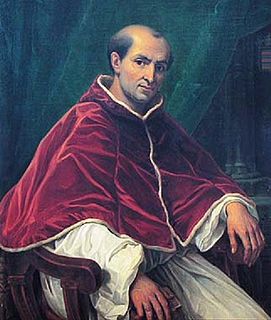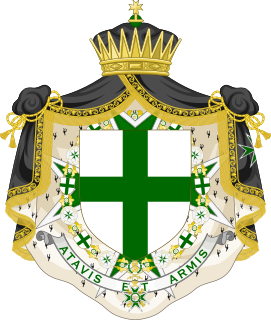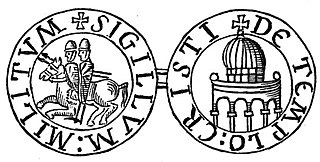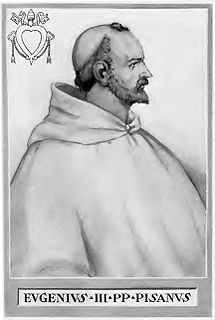
Pope Clement V, born Raymond Bertrand de Got, was Pope from 5 June 1305 to his death in 1314. He is remembered for suppressing the order of the Knights Templar and allowing the execution of many of its members, and as the Pope who moved the Papacy from Rome to Avignon, ushering in the period known as the Avignon Papacy.

The Council of Vienne was the fifteenth Ecumenical Council of the Roman Catholic Church that met between 1311 and 1312 in Vienne. Its principal act was to withdraw papal support for the Knights Templar on the instigation of Philip IV of France, after the French monarch attacked Rome and killed Pope Boniface VIII.

The Equestrian Order of the Holy Sepulchre of Jerusalem, also called Order of the Holy Sepulchre or Knights of the Holy Sepulchre, is a Roman Catholic order of knighthood under the protection of the Holy See. The Pope is sovereign of the Order. Founded as Milites Sancti Sepulcri attached to the Augustinian Canons Regular of the Holy Sepulchre in Jerusalem, recognised in 1113 by Papal bull of Pope Paschal II and of Pope Calistus II in 1122. It traces its roots to circa 1099 under the Frankish Duke Godfrey of Bouillon, Advocatus Sancti Sepulchri, "Defender of the Holy Sepulchre", one of the leaders of the First Crusade and first ruler of the Kingdom of Jerusalem. It is an internationally recognised order of knighthood.
Militia Dei is a papal bull issued by Pope Eugene III in 1145 that consolidated the Knights Templar's independence from local clerical hierarchies by giving the Order the right to take tithes and burial fees and to bury their dead in their own cemeteries. The Knights were allowed to travel through Europe freely.

The Order of Saint Lazarus of Jerusalem, also known as the Leper Brothers of Jerusalem or simply as Lazarists, was a Catholic military order founded by crusaders around 1119 at a leper hospital in Jerusalem, Kingdom of Jerusalem, whose care became its original purpose, named after their patron saint, Lazarus. It was recognised by King Fulk of Jerusalem in 1142 and canonically recognised as hospitaller and military order of chivalry under the rule of Saint Augustine in the Papal bull Cum a Nobis Petitur of Pope Alexander IV in 1255. Although they were centered on their charism of caring for those afflicted with leprosy, the knights of the Order of Saint Lazarus notably fought in the Battle of La Forbie in 1244 and in the Defense of Acre in 1291. The titular seat was successively situated at Jerusalem, Saint-Jean-d'Acre and - after the fall of the Kingdom of Jerusalem - split in two main branches in Italy and in Château Royal de Boigny-sur-Bionne in France.

Robert de Craon or Robert Burgundio was the second Grand Master of the Knights Templar from June 1136 until his death. He was a member of the Craon family, son of Renaud le Bourguignon and Ennoguen de Vitré.

The Supreme Order of Christ is the highest order of chivalry awarded by the Pope. According to some scholars it owes its origin to the same Order of Christ of the Knights Templar, from which came the Order of Christ that was awarded by the Kings of Portugal and the Emperors of Brazil. The Portuguese order had originally both a secular and religious component; by the 18th century, the religious component had died out.
The Chinon Parchment is a historical document discovered in September, 2001, by Barbara Frale, an Italian paleographer at the Vatican Secret Archives. On the basis of the Parchment, she has claimed that, in 1308, Pope Clement V absolved the last Grand Master, Jacques de Molay, and the rest of the leadership of the Knights Templar from charges brought against them by the Medieval Inquisition.
Pastoralis praeeminentiae was a papal bull issued by Pope Clement V on 22 November 1307 to all Christian monarchs. It ordered the arrest of all Knights Templar and to seize their properties on behalf of the church. Clement was forced to support the campaign against the Templars by Philip IV of France, who owed them a great deal of money and had initiated the first arrests against the Templars on 13 October 1307.
Vox in excelso is the name of a Papal Bull issued by Pope Clement V in 1312. The directives given within the Bull were to formally dissolve the Order of the Knights Templar, effectively removing Papal support for them and revoking the mandates given to them by previous popes in the 12th and 13th centuries.
In view of the suspicion, infamy, loud insinuations and other things which have been brought against the order ... and also the secret and clandestine reception of the brother of this Order; in view, moreover, of the serious scandal which has arisen from these things, which it did not seem could be stopped while the Order remained in being, and the danger to faith and souls, and the many horrible things which have been done by the very many of the brothers of this Order, who have lapsed into the sin of wicked apostasy, the crime of detestable idolatry, and the execrable outrage of the Sodomites ... it is not without bitterness and sadness of heart that we abolish the aforesaid Order of the Temple, and its constitution, habit and name, by an irrevocable and perpetually valid decree; and we subject it to perpetual prohibition with the approval of the Holy Council, strictly forbidding anyone to presume to enter the said Order in the future, or to receive or wear its habit, or to act as a Templar.
Datum is, from its Latin origin, a singular form of "data", and may refer to a single item of data.

The Knights Templar trace their beginnings to the Latin Kingdom of Jerusalem in c. 1120 when nine Christian knights, under the auspices of King Baldwin II and the Patriarch Warmund, were given the task of protecting pilgrims on the roads to Jerusalem, which they did for nine years until elevated to a military order at the Council of Troyes in 1129. They became an elite fighting force in the Crusades known for their propensity not to retreat or surrender.
Faciens misericordiam was a papal bull issued by Pope Clement V on August 12, 1308, as part of the trial against the Knights Templar. It called for a new Ecumenical council to be held in 1310, and set out some structure for the collection of depositions from the arrested Templars.
The history of the Knights Templar in England began when the French nobleman Hughes de Payens, the founder and Grand Master of the order of the Knights Templar, visited the country in 1128 to raise men and money for the Crusades.

The orders, decorations, and medals of the Holy See include titles, chivalric orders, distinctions and medals honoured by the Holy See, with the Pope as the fount of honour, for deeds and merits of their recipients to the benefit of the Holy See, the Catholic Church, or their respective communities, societies, nations and the world at large.

Pie postulatio voluntatis is a papal bull issued on 15 February 1113 by Pope Paschal II, in which the Pope formally recognized the establishment of the Knights Hospitaller and confirmed its independence and sovereignty. Today, the document is preserved at the National Library of Malta in Valletta, Malta.















